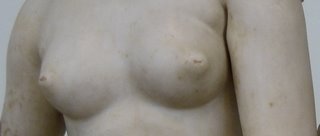
…to a dramatic Minoan bull’s head and a stunningly beautiful Mycenaean gold cup from 15th Century BC.


Walking through this museum requires the visitor to endure an almost-non-stop lightning storm of camera flashes each of which is followed by the thunderclap of attendants yelling: “No flash, please…”
Fortunately, we never offended - but only because we hissed "Flash off?" at one another every time we raised a camera to eye-level!

It might be easier to insist - as do many galleries around the world - that photography is simply not permitted, but then so many of the exhibits simply beg to be photographed - like this celebrated 16th Century BC gold funerary mask from Mycenae - the so-called ‘Agamemnon’ mask - which will evoke memories for every ‘A’ Level English student of a certain era, since it was featured on the cover of the Penguin paperback edition of the Oresteia…

Much of the art reflects the importance of the sea in Greek history and culture with powerful images of dolphins, fish and octopi - images which survived through to our own age, often in coarsened form, to decorate the folk-arty souvenirs which tourists carry home from Greece...

And many of the exhibits were, indeed, found in the sea - recovered and reclaimed from Poseidon’s personal treasure trove to amaze our 21st Century eyes, such as this bronze, galloping horse and jockey which was cast in 150 BC and which leaps through the air and across the years with a virile fury of straining sinew and equine energy…

The works displayed in the museum's sculpture galleries trace how the Greeks fashioned the sculptor's art into something totally revolutionary: learning from the Egyptians the skill of creating anatomically accurate, but rigidly formal, human likenesses that were essentially designed to look imposing when viewed head-on...

...and then found the inspiration and imagination to liberate their subjects and create statues that captured the illusion of three-dimensional movement and emotionally engaged the observer. It was a watershed in the history of art...

Again and again, throughout the museum, one is reminded just how uninhibited early cultures were compared even with our seemingly liberated times. And it was the gods and heroes who led the way: refusing to hide decorously behind inessential drapery but, instead, preferring to stand proud and unabashed in their sexuality...
In whatever direction you look you are confronted by Ancient Greeks' not-so-private parts...



Not surprisingly, today’s gallery-goers - feigning artistic curiosity - are unable to avert their eyes: weighing things up, making mental measurements and comparisons...

...and, if they can break away from their tour companions, they inevitably move in for a closer peek...

...or to snap off a few shots of the naturists of Hellas!

 One of the most startling - in fact, eye-watering - exhibits in the museum’s collection is this bronze statuette of a prodigiously randy satyr, dating from the 6th Century BC...
One of the most startling - in fact, eye-watering - exhibits in the museum’s collection is this bronze statuette of a prodigiously randy satyr, dating from the 6th Century BC...One can't help but think what a time Ann Summers would have had back then!
This particular image, I have to admit, is taken from a post-card. David did take a photograph, but for some reason - I can't imagine why - it suffered from camera-shake!
The satyrs and fauns of mythology are a far cry from the decorously civilized Mr Tumnus of The Lion, the Witch and the Wardrobe and their lustful larks are part of an essentially earthy heritage that has not been entirely lost in the intervening millennia.
When we on Kalymnos, I was frequently reminded that Greek people - well those of the islands at any rate - can be surprisingly - even shockingly - direct and basic when it comes to questions of sex.
When, for example, I mentioned the fact that my late friend, the actor Peter Bull (who had a summer home on Paxos), had written a book called Life is a Cucumber - the title of which was taken from an old Arab proverb adopted by the Greeks - we were immediately treated to a graphic visual representation from the kitchen…

The white stuff on the end of the cucumber -- I mention it only because you want to know, but will be far too polite or embarrassed to ask! -- is ice cream: an outrageous embellishment by one of the UK contingent who - succumbing the Hellenistic atmosphere of libidinous freedom - momentarily lost his sense of British decorum!
And on the slopes of Mount Olympus, Pan and his goat-footed followers were, doubtless, convulsed with laughter...
Incidentally, for the curious among you, the full version of that proverb runs as follows:
“Life is a cucumber... It is sometimes long, sometimes short; sometimes rough, sometimes smooth; sometimes bitter, sometimes sweet… One minute it’s in your hand --- next minute, it’s UP YOUR ARSE!”
But now our sojourn in the sun is over and it’s time to do up all our zips and buttons and head off to that island in the North Sea where, most of the time, temperatures are comparable with our libido ratings!

[Images: © Brian Sibley & David Weeks]
1 comment:
Scrooge asks how did we manage to take such cracking pictures with no flash?
Using Canon Digital Ixus 40 & Ixus 50 cameras (the later has more mega-pixels and is usually, but not always, the camera responsible for the sharper images), a reasonably steady hand (David is better at this than me - except when confronted with full-frontal sexually-aroused satyrs!) and, naturally, the radiance of our personalities!!
Post a Comment